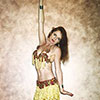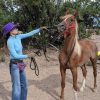Exercise Is The Basis of
Health, Strength & Beauty
Bellydancing
Tanya joined her first bellydance troupe in Santa Fe, New Mexico when she was 9 years old. She was affectionately known as the ‘baby bellydancer.’ By the time she was 15 years old, Tanya was performing as a solo bellydancer and she began teaching bellydancing at the Early Street Studios. At the age of 18, Tanya was performing her bellydancing in San Francisco, California. By the age of 20 years old, Tanya was bellydancing in Phoenix, Arizona at Arabic nightclubs, Moroccan and Greek restaurants and private parties. She bellydanced with live Arabic and Greek bands six nights a week, two 45 minute shows a night. She continued to bellydance in Santa Fe with a Flamenco band. This band performed a set of Flamenco-Arabic fusion music especially created for Tanya. Tanya also formed the Mahabbi Cabaret Bellydance Troupe as well as the Goddesspower Bellydancers, a lively group of women of all ages who performed on stage in theatres, plazas, parks, colleges and nightclubs throughout Santa Fe and Albuquerque.
The ancient Babylonians recorded the organized hierarchy of women who worshiped the Goddess Ishtar. The top ranking priestesses were called ‘entu’ and their status was equal to those of the male priest. The Babylonian ‘naditu’ ranked next in importance to the ‘entu’ and these women were drawn from the highest families in the land. In dedicating their lives to the Goddess, they were supposed to remain single and childless. The ‘naditu’ led full and active lives, lending money and grain and managing land and people. They were an essential part of the economy of the country. Beneath the ‘naditu’ were the ‘qadishtu’ (sacred women) and the ‘ishtaritu’ who specialized in the arts of dancing, music and singing. The ‘ishtaritu’ danced the undulating Bellydance.
Bellydance is an early creation dance and a part of the goddess rites of ancient Babylonia. The dance is characterized by snakelike and vigorous hip and pelvic movements, the manipulation of veils, a descent to the floor and ritual wearing of a hip-belt which is linked to the girdle, Goddess Ishtar’s symbolic emblem. The snake symbolized immortality and it was regarded as a protective spirit. The snake’s coils inspired the undulations of the Bellydance.
The Bellydance was usually performed at all-female gatherings. The belly is the center of birth. Thus, bellydancing is also a birth mime. Young women in harems were taught the bellydance during their pregnancies to help prepare them for natural childbirth. The Bellydance served as a rhythmic, soothing reminder to the woman in labor to use her abdominal muscles to aid the birth process.
Bellydance is a Goddess rite to Tanya. When she bellydances or teaches bellydancing, she celebrates feminine Goddess Power, Energy and Health. Tanya is available to teach bellydance classes and workshops. She will teach fully choreographed Egyptian cabaret Bellydances to Bellydance troupes or individuals.




See Tanya’s Horse Goddess page
Find out about Tarot Readings
and Tanya’s Line Dancing










